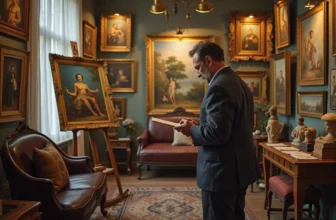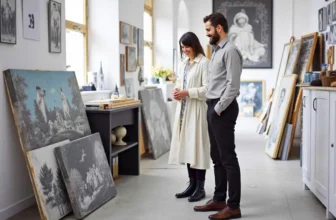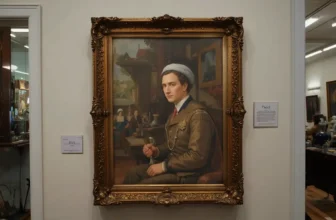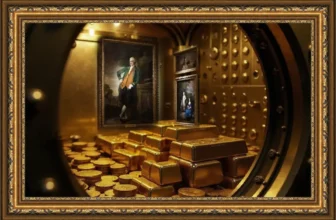The Top 10 Classic Painters Whose Art Is a Safe Investment
Shopping Ads: Invest in Hidden Masterpiece: Rare Antique Oil Paintings For Sale. Limited Originals Available 💰😊 Are you looking for authentic hidden masterpiece? Explore old master antique oil paintings from the Renaissance and Baroque eras. From 16th-century portraits to 18th-century landscapes. Authenticity guaranteed, Old Master antique oil paintings for sale. Shop Now! 🎨 Renaissance And Baroque Art Old Master Portrait Paintings Landscape Antique PaintingsInvesting in art has fascinated collectors, investors, and culture enthusiasts for centuries. Unlike volatile financial markets, fine art, especially works created by classic painters, has long been regarded as a safe investment, both preserving and increasing in value over time. While trends in contemporary art can shift rapidly, the legacies of timeless masters remain steady, ensuring their artworks are among the most reliable assets for those seeking long-term security.
In this article, we will explore the top five classic painters whose art is widely considered a safe investment. Each of these artists has left an enduring mark on cultural history, consistently commanding high prices at auction houses like Christie’s and Sotheby’s, while also offering prestige and emotional enrichment to collectors.
We will also discuss what makes their works safe investments, current market dynamics, and why their masterpieces continue to appreciate in value.
Why Classic Painters Are Considered Safe Investments
Before diving into specific artists, it’s important to understand why art by classic painters holds enduring investment value:
Scarcity and Irreplaceability
Unlike modern artists still producing work, classic painters are no longer alive, which means no new original artworks will ever enter the market. This finite supply naturally drives demand.Cultural and Historical Value
These painters shaped artistic movements that defined eras, ensuring their legacies remain part of human history and culture. This deep cultural significance adds intrinsic value.Auction Market Stability
Works by classic painters consistently appear in major auctions and sell for millions, establishing a price history that reassures investors.Diversification from Traditional Assets
High-net-worth individuals often invest in fine art to diversify their portfolios and hedge against inflation or stock market downturns.Proven Long-Term Appreciation
Studies and art market reports show that blue-chip art, works by iconic classic painters, has outperformed many traditional investments over decades.
With this foundation, let’s explore the five painters whose art is both timeless and financially rewarding.
1. Leonardo da Vinci (1452–1519)
When discussing safe art investments, it is impossible to ignore Leonardo da Vinci. Known for masterpieces such as The Mona Lisa and The Last Supper, Leonardo is often regarded as the greatest painter of all time.
Why Leonardo’s Art Is a Safe Investment
Extreme Rarity: Fewer than 20 paintings are universally attributed to Leonardo, making his works among the scarcest in the world.
Record-Breaking Prices: In 2017, Salvator Mundi sold at Christie’s for $450.3 million, setting the record for the most expensive painting ever sold.
Global Cultural Significance: Leonardo’s works transcend art; they represent human ingenuity, scientific inquiry, and Renaissance ideals.
Investment Value
Owning a Leonardo da Vinci is nearly impossible for private collectors today because most are held in museums like the Louvre. However, even drawings or authenticated studies attributed to him can fetch tens of millions. Investors also benefit from indirect exposure, such as investing in funds specializing in Old Masters.
Leonardo’s reputation is essentially bulletproof, no economic downturn or market fluctuation can diminish his status. His works will forever symbolize the pinnacle of human creativity, making them one of the safest possible art investments.
2. Michelangelo Buonarroti (1475–1564)
Another Renaissance giant, Michelangelo, is celebrated for both his paintings and sculptures. While most of his iconic works, such as the Sistine Chapel ceiling and the David statue, are immovable, Michelangelo’s sketches, preparatory drawings, and smaller works are highly sought after.
Why Michelangelo’s Art Is a Safe Investment
Dual Legacy: Renowned as both a painter and sculptor, Michelangelo’s multi-disciplinary genius broadens his market appeal.
Limited Availability: Like Leonardo, Michelangelo’s original paintings are mostly in public collections, but his sketches and drawings surface occasionally in auctions.
Consistent Auction Performance: Michelangelo’s drawings have sold for millions, proving their enduring value. For example, a red chalk drawing sold at Christie’s for over $12 million in 2000.
Investment Value
While owning a Michelangelo fresco or marble sculpture is unattainable, collectors can still invest in his authenticated sketches and drawings. These items are highly liquid in the art market and carry the prestige of one of history’s greatest creative minds.
Given the eternal influence of his work on Western art and culture, Michelangelo represents a rock-solid safe investment for art collectors.
3. Rembrandt van Rijn (1606–1669)
Transitioning into the Baroque era, Rembrandt remains a cornerstone of classic art investment. Known for his mastery of light and shadow, as well as his deeply humanistic portraits, Rembrandt is one of the most studied and collected painters in history.
Why Rembrandt’s Art Is a Safe Investment
High Auction Demand: Rembrandt’s paintings regularly command tens of millions at auction. His 1634 double portraits Maerten Soolmans and Oopjen Coppit sold to the Louvre and Rijksmuseum jointly for $180 million in 2016.
Diverse Market Access: Beyond oil paintings, Rembrandt produced over 300 etchings and engravings, making it possible for collectors with different budgets to invest.
Global Prestige: Rembrandt’s work defines the Dutch Golden Age, ensuring his cultural relevance remains strong.
Investment Value
Rembrandt’s wide body of work offers investors multiple entry points. While original oil paintings are rare and often locked in institutions, etchings provide an affordable yet prestigious way to own part of his legacy. Because his work is so extensively documented, authenticity concerns are minimal compared to lesser-known artists.
For investors seeking both stability and potential appreciation, Rembrandt is a name that continues to inspire confidence.
4. Claude Monet (1840–1926)
Moving into the Impressionist movement, Claude Monet is among the most reliable painters when it comes to safe art investments. As the father of Impressionism, Monet’s work not only defined a new style but also transformed modern art.
Why Monet’s Art Is a Safe Investment
Market Strength: Monet consistently ranks among the top-selling artists at auction. His works are coveted by museums and private collectors worldwide.
Iconic Series: Paintings such as Water Lilies, Haystacks, and Rouen Cathedral are among the most recognized works in art history.
Auction Records: In 2019, Meules (one of his Haystacks) sold for $110.7 million at Sotheby’s, setting a new record for the artist.
Broad Collector Appeal: Impressionism is a universally admired style, and Monet’s works appeal to both seasoned investors and new buyers.
Investment Value
Monet’s market has shown remarkable resilience and growth. Even during times of economic uncertainty, Monet’s works maintain strong demand, often surpassing estimates at auction. With his paintings distributed worldwide, collectors see his art as a global currency of culture and wealth.
For investors seeking both prestige and financial appreciation, Monet is widely regarded as one of the safest bets.
5. Pablo Picasso (1881–1973)
No list of safe art investments would be complete without Pablo Picasso. As the 20th century’s most influential painter, Picasso produced over 50,000 works, spanning paintings, drawings, ceramics, and sculptures. His prolific output and revolutionary style make him a cornerstone of art investment.
Why Picasso’s Art Is a Safe Investment
Unmatched Market Liquidity: Picasso’s works appear at virtually every major auction, making them one of the most traded high-value art assets.
Diverse Range: From early Blue Period pieces to Cubist masterpieces, Picasso’s wide stylistic range appeals to different types of collectors.
Auction Dominance: Picasso frequently tops global sales rankings. His Les Femmes d’Alger (Version O) sold for $179.4 million in 2015.
Cultural Impact: Few artists shaped modern art as profoundly as Picasso, ensuring his relevance remains intact.
Investment Value
Picasso’s prolific nature means that while some works sell for under $100,000, others reach well over $100 million. This spectrum allows investors to enter the Picasso market at multiple levels. Importantly, Picasso’s name recognition and constant demand make his works among the most liquid and stable investments in the art market.
6. Johannes Vermeer (1632–1675)
Often called the “Sphinx of Delft,” Johannes Vermeer is renowned for his delicate domestic interiors and masterful use of light. His most famous painting, Girl with a Pearl Earring, has become an icon of world art.
Why Vermeer’s Art Is a Safe Investment
Extreme Scarcity: Only about 35 paintings are definitively attributed to Vermeer, making his works extraordinarily rare.
Auction Performance: When they appear, Vermeer’s paintings command astronomical prices. His The Guitar Player sold for £44,000 in 1887 (equivalent to millions today), and experts believe any new Vermeer discovery would exceed $100 million.
Cultural Fame: Vermeer’s influence on photography, cinema, and modern visual culture ensures timeless demand.
Investment Value
Because of scarcity, Vermeer paintings are almost entirely in museums. However, investors often target related items such as etchings, high-quality reproductions with provenance, and art funds that include Old Masters. Vermeer’s unparalleled rarity cements his place among the safest long-term art investments.
7. Francisco Goya (1746–1828)
A bridge between Old Masters and modern art, Francisco Goya produced works that were politically charged, emotionally raw, and technically brilliant. His versatility, from royal portraits to haunting pieces like The Third of May 1808, has made him a favorite among collectors.
Why Goya’s Art Is a Safe Investment
Dual Market: Goya’s paintings sell for tens of millions, while his prints and etchings (such as the Los Caprichos series) are accessible to mid-range collectors.
Enduring Demand: Goya’s influence on later masters like Picasso ensures continued relevance.
Cultural Importance: His unique combination of Romanticism and realism appeals across generations.
Investment Value
For investors, Goya offers flexibility. Original paintings are rare and expensive, but his etchings appear at auctions regularly. With consistent demand and cultural resonance, Goya represents both prestige and stability for art investors.
8. Edgar Degas (1834–1917)
Known for his depictions of dancers, racehorses, and Parisian life, Edgar Degas was a leading Impressionist whose works combine modernity with technical mastery.
Why Degas’s Art Is a Safe Investment
Strong Auction Market: Degas paintings, pastels, and sculptures consistently perform well at Sotheby’s and Christie’s. Danseuse au repos sold for $37 million in 1999.
Diverse Mediums: He produced paintings, drawings, pastels, and bronze sculptures, offering investors different levels of entry.
Widespread Appeal: Degas’s ballet scenes are universally recognized and admired.
Investment Value
Degas is a blue-chip name in the Impressionist market. His works, especially pastels and bronzes, offer reliable appreciation. For investors seeking both beauty and financial security, Degas remains one of the safest choices.
9. Vincent van Gogh (1853–1890)
Although he only sold one painting during his lifetime, Vincent van Gogh is now one of the most celebrated and valuable artists in history. Works like Starry Night and Sunflowers symbolize modern art itself.
Why Van Gogh’s Art Is a Safe Investment
High Auction Records: In 1990, Portrait of Dr. Gachet sold for $82.5 million, equivalent to over $160 million today. In 2021, his Wooden Cottages Among Olive Trees and Cypress Trees fetched $71.3 million.
Cultural Fame: Van Gogh’s story of struggle and genius ensures enduring global appeal.
Limited Supply: With only about 900 paintings, Van Gogh’s body of work is finite and highly coveted.
Investment Value
Van Gogh paintings are among the most expensive artworks in the world, typically held by institutions. For investors, exposure often comes through prints, sketches, or fractional investment platforms. His art is considered a gold standard for safe investments due to cultural prestige and consistent market demand.
10. Henri Matisse (1869–1954)
A pioneer of Fauvism, Henri Matisse is celebrated for his bold colors, simplified forms, and expressive compositions. His works embody vibrancy and innovation.
Why Matisse’s Art Is a Safe Investment
Auction Performance: His painting Odalisque couchée aux magnolias sold for $80.8 million in 2018, setting a record for the artist.
Global Influence: Matisse’s art shaped modern design and continues to influence fashion, interiors, and visual culture.
Variety of Works: From paintings and drawings to cut-outs and prints, Matisse offers diverse entry points.
Investment Value
Matisse’s broad collector base and strong historical importance make him a safe and dynamic investment. His art also appeals to both seasoned collectors and new investors seeking stability with modern relevance.
Comparing the Top 10 Classic Painters as Investments
| Painter | Era | Type of Works Available | Record Sale Price | Investment Security |
|---|---|---|---|---|
| Leonardo da Vinci | Renaissance | Extremely rare paintings, drawings | $450.3M (Salvator Mundi) | Very High |
| Michelangelo | Renaissance | Drawings, sketches | $12M+ | High |
| Rembrandt | Baroque | Paintings, etchings | $180M (Double Portraits) | High |
| Johannes Vermeer | Baroque | Paintings (very scarce) | Estimated $100M+ | Very High |
| Francisco Goya | Romanticism | Paintings, etchings, prints | $7.4M+ (etchings), tens of millions (paintings) | High |
| Claude Monet | Impressionism | Paintings, drawings | $110.7M (Meules) | Very High |
| Edgar Degas | Impressionism | Paintings, pastels, bronzes | $37M (Danseuse au repos) | High |
| Vincent van Gogh | Post-Impressionism | Paintings, drawings | $82.5M (Portrait of Dr. Gachet) | Very High |
| Pablo Picasso | Modern | Paintings, drawings, ceramics, sculpture | $179.4M (Les Femmes d’Alger) | Very High |
| Henri Matisse | Modern | Paintings, drawings, cut-outs | $80.8M (Odalisque couchée aux magnolias) | High |
Factors to Consider Before Investing in Classic Painters
While investing in the works of these legendary painters is considered safe, there are key considerations to keep in mind:
Authenticity and Provenance
Always verify the provenance of an artwork. Counterfeits and attribution issues can significantly impact value.Condition of the Artwork
Well-preserved works with minimal restoration hold greater value.Liquidity and Market Timing
While these works generally sell quickly at auction, timing your sale can affect returns.Storage and Insurance Costs
Art requires secure storage and comprehensive insurance, which adds to overall investment costs.Access to the Market
While Picasso and Rembrandt offer more accessible entry points, Leonardo and Michelangelo are reserved for elite collectors or institutions.
The Enduring Value of Classic Art
The art market has shown remarkable resilience through wars, recessions, and global financial crises. Unlike speculative assets, the works of classic painters endure across centuries, consistently attracting demand.
For investors, these masterpieces represent more than just financial assets, they embody cultural heritage, beauty, and a tangible connection to history. Owning even a modest piece related to these artists can provide both emotional fulfillment and financial security.
When it comes to safe investments in art, Leonardo da Vinci, Michelangelo, Rembrandt, Claude Monet, and Pablo Picasso stand out as the most reliable choices. Their works represent the pinnacle of artistic achievement, cultural importance, and financial stability.
While not every collector can afford a da Vinci painting or a Picasso masterpiece, entry points exist at various levels, through drawings, prints, or even investment funds specializing in blue-chip art. The key is to prioritize authenticity, provenance, and market demand.
In the end, investing in classic painters is not only a financial strategy but also a way of preserving and participating in the legacy of human creativity. For those seeking stability in an unpredictable world, the works of these masters remain among the safest and most rewarding investments in history.




